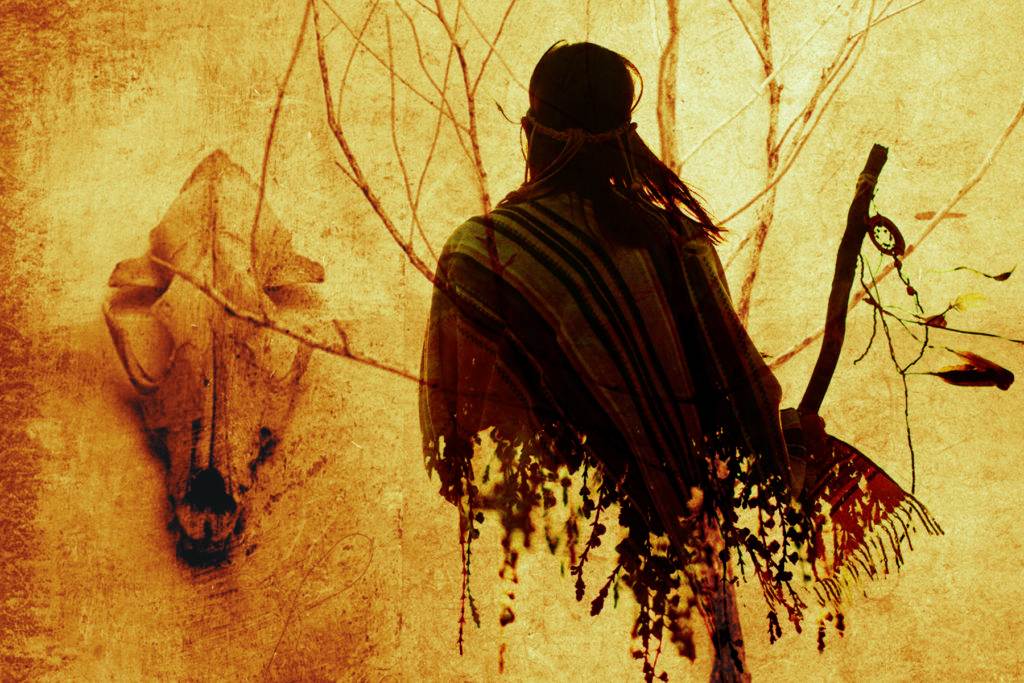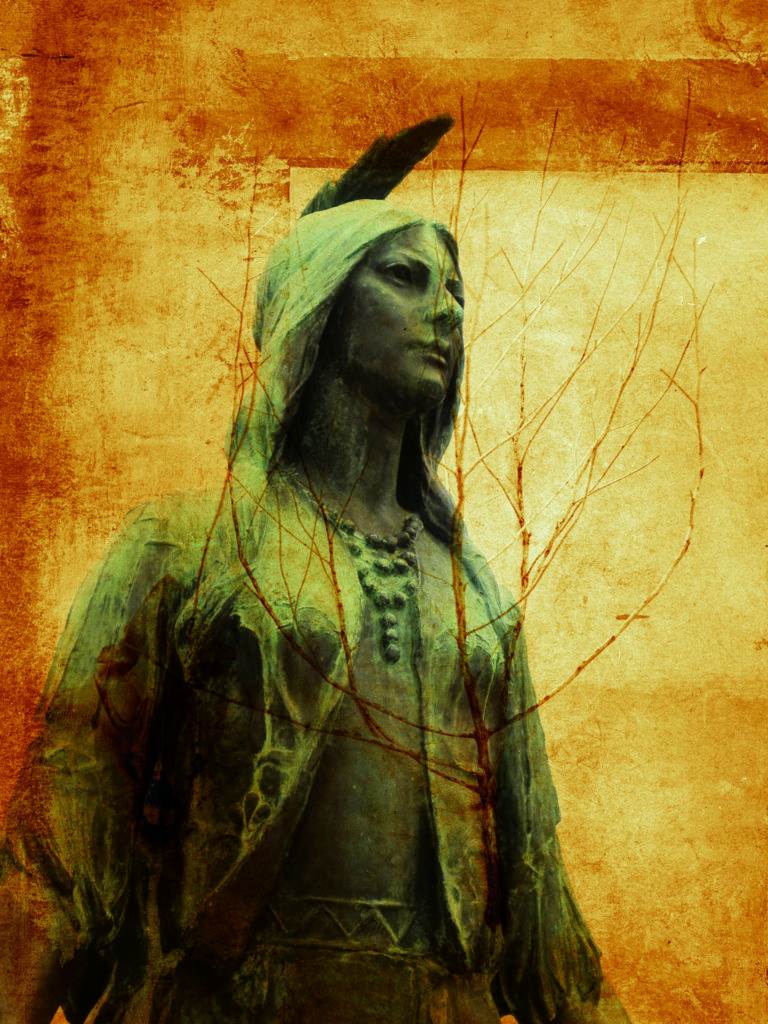Native American Women
and the Struggle for
Representation
BY FRANCES V. RAINS
When invited to write this piece for Women’s History Month, I began to hear the murmurs of Native American* women—past and present—raising a multitude of issues that few who are not Indian know about. I call them “murmurs in the wind” because Native American women have been erased from our collective memories. Beyond the “good Indians” like Pocahontas (Powhatan) and Sacajawea (Shoshone)—known for aiding European and European Americans in their quest for more land—we remember very little about Native American women. There are many reasons for this, grounded in everything we are (not) taught in school, including the imagery of Native American women being used in negatively stereotypical ways. But even when the imagery has shown Native American women beautifully, it is still done stereotypically, whether by Disney or Land O’Lakes butter.
As a Native woman (Choctaw/Cherokee and Japanese) and educator, I struggle with how to bring some of these murmurs in the wind to actual voice when few know much about Native Americans in general. It is difficult to talk about present-day Native American women when I am told by many that “Native Americans are all dead.” So the issues that these murmurs in the wind raise become quickly muted in the face of stereotypes and misinformation (and I can assure you that members of the 566 existing sovereign Native Nations would take offense to being thought of as dead). Therefore, in this brief article I will only focus on two issues. One is what African American scholar Carter G. Woodson called “mis-education.” Like Dr. Woodson, I want to break down some of this mis-education so that new learning is possible. The other issue is to bring some contemporary Native women to the forefront.

We often study the history of this land beginning with 1492. Logical, perhaps, from a Euro-American standpoint. However, from a Native viewpoint, history here did not begin with Columbus. Native people have been here for between 10,000 and 20,000 years. Not just Native men but Native women as well. This may sound like an obvious point—that Native women have been here for a long time—but it has direct bearing upon how we understand women’s history. We neglect the longer history and the relationship of Native Nations to this land when we begin history here with 1492. Native women were here before European men and long before European women—Europeans did not typically bring their women with them until almost a hundred years later. Many Native Nations on the coastline, where contact between Europeans and Native peoples first occurred, recorded through oral traditions that the Europeans seemed odd, as they forgot to bring their women!
What bearing does this have on understanding Native American women? In most Native Nations, women’s roles—while different from men’s—were deemed no less important in maintaining survival. Native women often belonged to women’s societies or clans. Native women often had the same rights as the men in their nation, having a say in political matters, and often the rights of property and kinship of the children. Native women could divorce their husbands and take the children with them, something that would have been unheard of in Europe at the time of colonization and conquest.
When one considers that the European men brought European beliefs about women, then it has a bearing on how Native women were described and thereby “understood.” It was the European men who did the documenting. These strange men were often not privy to the Native women’s societies—they had no access. Therefore, using their own lenses and different understandings of European women as a form of measure, the European men often described Native women as “dirty squaws.” These men often assumed that Native women were slave-like and interpreted their role as subservient to Native men.
These men did not observe the freedoms the Native women had within their nations. They did not see how the Native women might, for example, select and vote on the next chief. The Native women were simply seen as always working. But the European men missed how the work that these women did was not simply necessary but was the way that they shared news and the way they educated their daughters about medicinal plants or foods, how to heal, how to care for the young, and how to maintain the shelters, which were often considered the property of the women, to be passed down through the generations.

These men did not realize that Native women had the right to make their own decisions, political or social. These rights were rarely shared by their white sisters in the colonies nor likely by white women in Europe. Yet if we reflect on what we learn about Native women at the time of colonization, aside from Pocahontas and Sacajawea, we learn very little besides the potentially faceless, silent, voiceless “squaw.”
In addition, the European men who first came often brought with them a political lens steeped in a feudal tradition. This affected the terminology used to address some Native peoples. For example, when Metacomet (Wampanoag), son of Massasoit and leader of the Wampanoag Confederacy, began a resistance against the colonists for encroachment of lands and the killing of Indians in what is now Massachusetts and Rhode Island, the colonists called him “King Phillip” and called this resistance “King Phillip’s War.” Application of the title “king,” or even “princess” was grounded in the feudal European political practice of the times. Therefore, it was not a great leap to call someone like Pocahontas, for example, an Indian “princess.” Yet Native people did not have kings—and thus, no princesses. This has a bearing on how we understand Native women, as we often hear the phrase “Cherokee Indian princess” in relation to someone’s ancestry. Native women are neither silent “squaws” nor are they Indian “princesses” in ancestry or for Halloween.
Which brings me to the other “murmuring” I want to raise. That is the issue of contemporary Native women. Most do not learn about Native women in the 20th century, let alone today. Some do not even know that a Native woman ran for vice president in 1996 and 2000. Winona LaDuke (Mississippi Band Ojibwe) is a leader and activist concerned about protecting the environment, especially reservations and Native homelands, where nuclear waste, PCBs, and other toxic contaminants often pollute the land and water. She has worked to have the US government honor treaty rights. And she continues to promote traditional ways of life for her people.
We rarely learn of other Native women—for example, Wilma Mankiller (Cherokee), the first woman from her nation to be elected “Principal Chief.” She was re-elected twice before she stepped down for health reasons. We do not often learn about Native women like Ada Deer (Menominee), who went before the Senate and House of Representatives in the early 1970s to plead for a reversal of a federal policy that, in 1954, had experimentally terminated her tribe. In 1973, the Menominee Restoration Act was signed by President Nixon. In 1992, Ada Deer was invited by President Clinton to become the first Native woman to be assistant secretary of the Bureau of Indian Affairs. And these are only two of the Native women currently engaged in politics at the tribal or federal level.
At the same time, there are many Native women poets, artists, musicians, lawyers, doctors, firefighters, teachers, actresses, authors, activists, and even professors! I encourage you to consider learning more about Native women, both from the past and in the present. After all, women’s history doesn’t begin with Seneca Falls or even with the first female colonists. Here on this land, women’s history begins with Native women.
*I do not speak for all Native people in my usage choice. I use “Native American” and “Native” women interchangeably. Please know that Native people make their own choices about how to identify, but most will use their tribal affiliation first (for example, Choctaw, Comanche, Ho-Chunk, Dine, Anishinaabe, to name just a few), and only when speaking more broadly will many use “American Indians,” “Indians,” “Natives,” or “Native Americans.”
Frances V. Rains, PhD, is a faculty member in Native American and World Indigenous Programs at Evergreen State College.